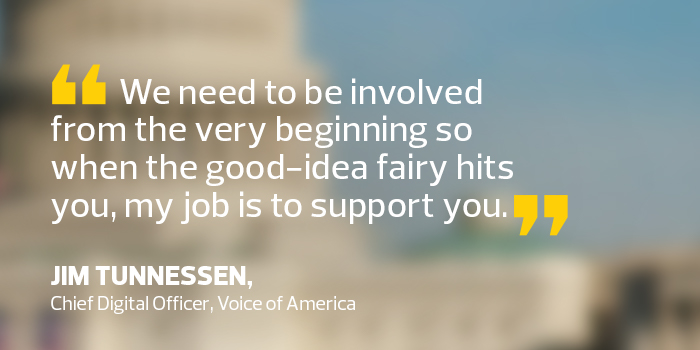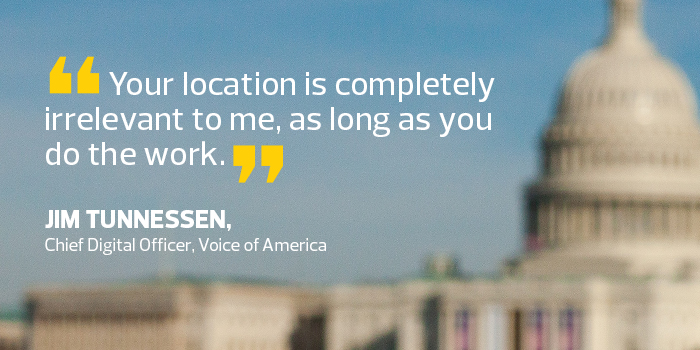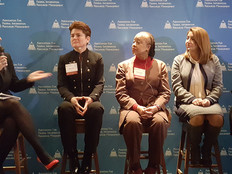Q&A: Jim Tunnessen Thinks Virtual Reality Should Replace VCRs in IT Modernization Push
When Jim Tunnessen delivered a keynote address last fall, his slide deck consisted largely of GIFs that had gone viral. His government lanyard reads “Free Throat Hugs” and depicts Star Wars’ Darth Vader.
Tunnessen is committed to changing the culture of government IT— in big ways and in small — and recently started work at his fourth federal organization. In January, he became chief digital officer for Voice of America, the wide-reaching international radio and television network managed by the Broadcasting Board of Governors.
FedTech Managing Editor Mike Gruss spoke with Tunnessen about the mechanics of culture change and how organizations should view the role of the CIO.
FEDTECH: You’ve worked at several federal agencies. What’s the major impediment to making changes in federal IT?
TUNNESSEN: The culture needs to change across the board. You need a culture that breeds empowerment and lets people know they can make these changes. Take the lead, show us how to do it, and we will follow suit. Think of commercial labs, where you have this environment with engineers and business people and artistic people, but there is an open environment where you can talk and generate new ideas.
FEDTECH: I’ve heard you say that in one of your jobs, some employees asked you if they were literally allowed to speak to another employee.

TUNNESSEN: Even worse, it wasn’t outside of the IT department; it was within the IT department.
FEDTECH: So how do you fix that?
TUNNESSEN: At the Department of Homeland Security’s Citizenship and Immigration Services, I was famous for saying, “Your location is completely irrelevant to me, as long as you do the work.” I had teams all over the country. They didn’t have cameras on their computer so I ordered cameras for everybody. We had conversations where they were in California and I was sitting in D.C. or Burlington, Vt. This allowed us to virtualize some of our toolset.
FEDTECH: Does that include using the cloud to break down the silos between departments?
TUNNESSEN: That’s exactly what I did. I had this big project and went to the CIO and said, “Hey, I am not doing this inside of our data centers. If we are doing this, I need a cloud environment.” The advantage was auto load balancing and auto scaling. I can provision and tear down. I don’t have to rely on the data center ops team to make my stuff for me because I can do it from my desktop.
FEDTECH: Explain the unique connectivity challenge you faced as chief technology officer at the Agriculture Department’s Food Safety and Inspection Services.
TUNNESSEN: Our inspectors need to be in every plant. We need a connection to all of these locations, 6,000 nodes throughout the country. Not everybody needs a device, but there needs to be at least connectivity to our network, to our solutions. That leads to a connectivity challenge. Nobody wants a food processing plant next to their house, right? Many are very remote. With that comes not only direct lines to these plants but also alternative methods to get people connected, using things like Mi-Fi and anything from mobile or satellites.
FEDTECH: You’ve talked about how training sets the tone for an agency’s IT efforts. How did FSIS use technology to help train inspectors?
TUNNESSEN: When I got to FSIS, we flew to one of our labs and went on a tour. We opened the door, and there is this ginormous box television with a VCR attached. They said, “This is how we train our new employees.”
I lost it. Let’s take the worst-case scenario: I am some 18- to 22-year-old college student who is graduating and, on the day I start, you are going to start playing VHS tapes from the 1980s?
Instantly I said, “We can fix this. We can digitalize these tapes and make them available on the internet.” Then, I went to our office where our head of training had this whole suite of virtual reality solutions. He had already done some filming at some of the plants, putting in the 360-degree cameras. He showed me a slaughterhouse, a cow moving down the line. It was enlightening because I am immersed in the sound and the visuals. No matter where I turn, I am there.

FEDTECH: How does that help?
TUNNESSEN: It allows for better recruiting. There is a high attrition rate in hiring new inspectors, because they don’t exactly understand what they have gotten themselves into. So we have our recruiting teams at universities and have the goggles, saying, “This is what you are walking into.” If someone gets that experience right away, their response is either yes or no.
FEDTECH: As a leader, how do you alter how people inside of your organization think about IT?
TUNNESSEN: Not everybody comprehends the benefits from using the CIO properly. IT shouldn’t be an afterthought. We need to be involved from the very beginning so when the good-idea fairy hits you, my job is to support you.
I need to make sure that when you ask for a hammer, I am not going to give you a screwdriver and say, “Hey, guess what, make it work.” But in doing so, we need to look at things and ask, “What are you trying to accomplish?” Don’t come in and say, “I need this system built in Java to do this,” because it may not need that.
FEDTECH: How does turnover on your team ultimately help the federal government?
TUNNESSEN: I want my employees to leave and go work at a different organization, not a federal organization and not for one of the contractors, but go to GE, go to Silicon Valley and get new experiences, learn new things and then come back, so we’re not stuck in that mindset of “it will take me six months to a year in order just to get this type of project.”









